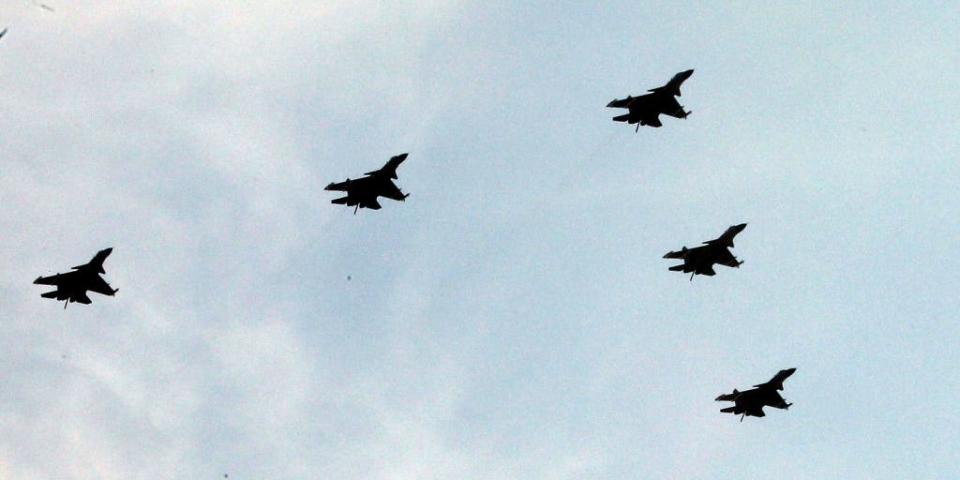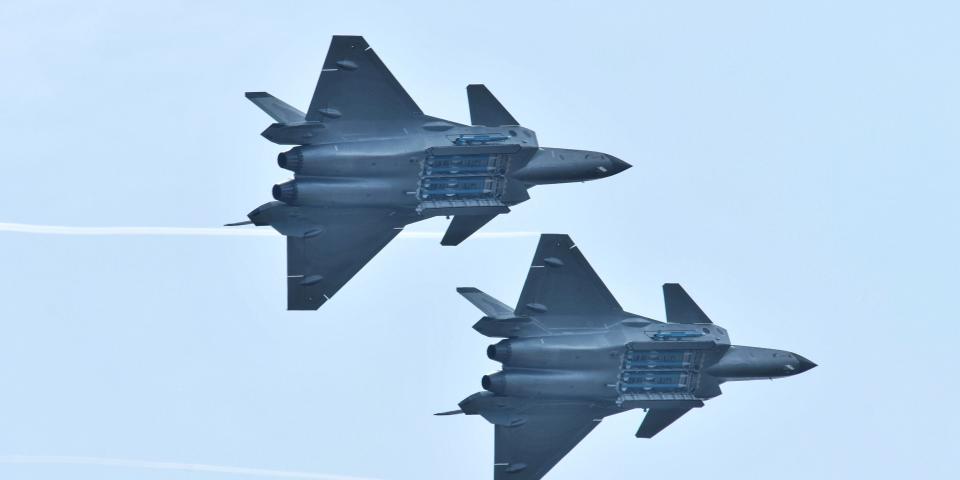China says its fighter pilots are battling AI aircraft in simulated dogfights, and humans aren't the only ones learning

- Oops!Something went wrong.Please try again later.
China has been pitting pilots against AI-driven aircraft in training simulations.
A commander told the PLA Daily that the AI aircraft were "sharpening the sword" for Chinese pilots.
The AI was also learning, highlighting the potential for AI systems in China's armed forces.
Chinese fighter pilots have been battling aircraft piloted by artificial intelligence in simulated dogfights to boost pilot combat skills, Chinese media reported this week.
Fang Guoyu, a People's Liberation Army Air Force brigade flight team leader and pilot recognized for his skills, was recently "shot down" by an AI adversary in an air-to-air combat simulation, according to People's Liberation Army Daily, the official newspaper of the Chinese military.
He said that early in the training it was easy to defeat the AI adversary. But with each round of combat, the AI reportedly learned from its human opponent. After one fight that Fang won with a bit of skillful flying, the AI came back and used the same tactics against him, defeating him.
"It's like a digital 'Golden Helmet' pilot that excels at learning, assimilating, reviewing, and researching," Fang said, referring to the elite pilots who emerge victorious in China's Golden Helmet air-combat contests. "The move with which you defeated it today will be in its hands tomorrow."
Du Jianfeng, the brigade commander, told the newspaper that AI was increasingly being incorporated into training.
It "is skilled at handling the aircraft and makes flawless tactical decisions," he said, characterizing the AI adversary as a useful tool for "sharpening the sword" because it forces the Chinese pilots to get creative.
'Sharpening the sword'

China is striving to build a modern military with the ability to fight and win wars by the middle of this century. It has made progress in recent years in its air-combat element, even developing a fifth-generation stealth fighter.
But far more challenging and time-consuming than closing the technology gap is cultivating the critical knowledge and experience required to effectively operate a modern fighting force.
Chinese media didn't offer specifics on the simulator, which they said was developed by the military in cooperation with research institutes, so there are still questions about whether the AI adversary provides sufficiently realistic training to prepare pilots to dogfight manned aircraft.
"If it does, that's pretty good," retired US Navy Cmdr. Guy Snodgrass, a former TOPGUN instructor and an expert in artificial intelligence, told Insider.
"If it doesn't," he continued, "you're really just training human operators to fight AI, and that is probably not what they are going to be going up against," since there are no autonomous AI-driven fighter aircraft they would need to be prepared to fight.
"There could be a divergence between real capability in a dogfight or aerial battle versus what the AI is presenting," he said. If that's the case, it could be a wasted effort.
If it's a high-fidelity training simulator, though, it could lower the cost of the air-combat training, as "you're able to get that training at a price point that's much lower than actually putting real planes in the air," Snodgrass said. It also lowers the risk.
Chinese leader Xi Jinping has repeatedly stressed the need for realistic combat training, including simulations, to help the Chinese military overcome a lack of combat experience, but it is not clear to what extent his agenda has been implemented with training simulators like what the air force's pilots have been using.
'The AI is learning, and it's getting better'

Regardless of whether the pilots are learning anything valuable, Fang's recollection of his engagements with his AI adversary suggests the AI is, though it is unclear to what extent.
"AI requires feedback," Snodgrass said. "And that's exactly the kind of pathway you'd want to take, to use this to help train your pilots, but because your pilots are fighting against it, the AI is learning, and it's getting better."
He said that a next step, assuming the technology reached that stage of development, could be to say: "This has performed very well in a virtual environment. Let's put this into a manned fighter."
China has invested heavily in AI research, and, like the US, it has been considering ways to incorporate AI - which can process information quickly and gain years of experience in a short time - into its aircraft.
Yang Wei, the chief designer for the J-20, China's first fifth-generation stealth fighter, said last year that the next generation of fighter could feature AI systems able to assist pilots with decisions to increase their overall effectiveness in combat, the state-affiliated Global Times reported.
The US Air Force has expressed similar ideas. Steven Rogers, a senior scientist at the US Air Force Research Laboratory, told Inside Defense in 2018 that ace pilots had thousands of hours of experience - "what happens if I can augment their ability with a system that can have literally millions of hours of training time?"
Snodgrass said there were several ways AI could augment the capabilities of or support human pilots in combat.
For instance, artificial intelligence could be used to monitor aircraft systems to reduce task saturation, especially for single-pilot aircraft; collect battlefield information; and handle target discrimination and prioritization. AI could even chart flight paths to minimize detection through electromagnetic-spectrum analysis.
Later, the military could look at putting AI in an unmanned autonomous fighter aircraft to fight alongside manned aircraft or serve as attritable warfighting platforms in contested environments. That's a more difficult challenge.
The US military is pursuing several efforts exploring the possibilities of AI technology. In an event last summer, for example, the Defense Advanced Research Projects Agency put an AI algorithm up against an experienced human pilot in what was described as "simulated within-visual-range air combat."
The artificial intelligence, which had already defeated other AI "pilots" in simulated dogfights and collected years of experience in a matter of months, achieved a flawless victory, winning five straight matches without the human, a US Air Force F-16 pilot, ever scoring a hit.
The point of the simulated air-to-air combat scenario was to advance DARPA's Air Combat Evolution program.
The agency has said it envisions "a future in which AI handles the split-second maneuvering during within-visual-range dogfights, keeping pilots safer and more effective as they orchestrate large numbers of unmanned systems into a web of overwhelming combat effects."
It is not clear how long it would take to realize the agency's vision, but Snodgrass previously told Insider that he "would never bet against technological progress," especially considering "all the advancements that have occurred in the last decade, in the last hundred years."
Read the original article on Business Insider

